Themed collection Time-resolved methods in biophysics series

Time-resolved methods in biophysics. 10. Time-resolved FT-IR difference spectroscopy and the application to membrane proteins
The implementation of time-resolved FT-IR spectroscopy to the structural study of membrane proteins and their catalytic mechanisms offers complementary information to other structurally sensitive methods like NMR spectroscopy and X-ray crystallography.
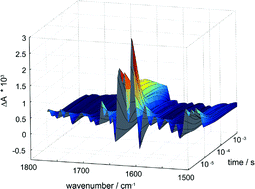
Photochem. Photobiol. Sci., 2009,8, 1517-1528
https://doi.org/10.1039/B9PP00050J
Time-resolved methods in biophysics. 9. Laser temperature-jump methods for investigating biomolecular dynamics
This perspective reviews the physical principles of the laser T-jump methodology, practical experimental considerations and specific applications of the laser T-jump to the broad range of problems in biomolecular dynamics.
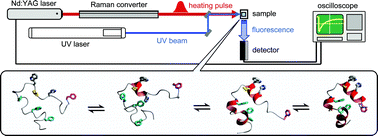
Photochem. Photobiol. Sci., 2009,8, 499-512
https://doi.org/10.1039/B819929A
Time-resolved methods in biophysics. 8. Frequency domain fluorometry : applications to intrinsic protein fluorescence
This review focuses on the development and modern implementation of the frequency domain approach to time-resolved fluorescence and its application to intrinsic protein fluorescence.
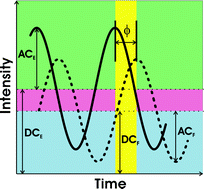
Photochem. Photobiol. Sci., 2008,7, 1301-1312
https://doi.org/10.1039/B804450N
Time-resolved methods in biophysics. 7. Photon counting vs. analog time-resolved singlet oxygen phosphorescence detection
Ultra-sensitive photon counting techniques are able to resolve nanosecond lifetimes of singlet oxygen O2(a1Δg), even in the presence of strong background luminescence signals, and to reliably measure quantum yields of O2(a1Δg) production below 0.001.

Photochem. Photobiol. Sci., 2008,7, 1003-1010
https://doi.org/10.1039/B804333G
Time-resolved methods in biophysics. 6. Time-resolved Laue crystallography as a tool to investigate photo-activated protein dynamics
Time-resolved Laue diffraction is particularly suitable for studying short-lived intermediates in light-sensitive proteins that can be repeatedly excited.

Photochem. Photobiol. Sci., 2007,6, 1047-1056
https://doi.org/10.1039/B704249C
Time-resolved methods in biophysics. 5. Femtosecond time-resolved and dispersed infrared spectroscopy on proteins
Femtosecond mid-infrared spectroscopy (right) combined with femtosecond visible spectroscopy (left) reveals environmental details of the chlorophylls involved in energy transfer in the light harvesting pigment–protein complexes CP43 and CP47.

Photochem. Photobiol. Sci., 2007,6, 501-507
https://doi.org/10.1039/B613023B
Time-resolved methods in biophysics. 4. Broadband pump–probe spectroscopy system with sub-20 fs temporal resolution for the study of energy transfer processes in photosynthesis
A femtosecond pump–probe system based on two synchronized NOPAs that can be independently configured to run either in the visible or in the near-IR frequency range is described.
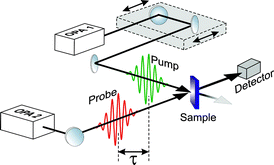
Photochem. Photobiol. Sci., 2007,6, 135-144
https://doi.org/10.1039/B606949E
Time-resolved methods in biophysics. 3. Fluorescence lifetime correlation spectroscopy
A thorough introduction into the recently developed fluorescence lifetime correlation spectroscopy.

Photochem. Photobiol. Sci., 2007,6, 13-18
https://doi.org/10.1039/B610310C
Time-resolved methods in Biophysics. 2. Monitoring haem proteins at work with nanosecond laser flash photolysis
Nanosecond laser flash photolysis can be exploited to monitor ligand binding kinetics to haem proteins, highlighting ligand migration processes and protein dynamics.

Photochem. Photobiol. Sci., 2006,5, 1109-1120
https://doi.org/10.1039/B610236K
Time-resolved methods in Biophysics. 1. A novel pump and probe surface-enhanced resonance Raman approach for studying biological photoreceptors
A time-resolved surface-enhanced resonance Raman spectroscopic method is presented that allows for studying electric-field effects on the light-induced reaction cycles of photoreceptors.
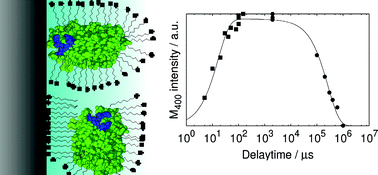
Photochem. Photobiol. Sci., 2006,5, 1103-1108
https://doi.org/10.1039/B607807A
About this collection
This series of perspectives aims at giving state of the art descriptions of time-resolved experimental approaches to the characterization of relevant biophysical and biochemical processes.
The suggestion for this collection of papers emerged from the lectures delivered at the X School of Pure and Applied Biophysics, "Time-resolved spectroscopic methods in biophysics", held in Venice at Palazzo Franchetti, in January 2006. The school was organized by Thomas Gensch and Cristiano Viappiani on behalf of the Societ`a Italiana di Biofisica Pura ed Applicata (SIBPA) and the Istituto Veneto di Scienze, Lettere ed Arti (IVSLA) and covered consolidated time-resolved spectroscopy methods as well as frontier techniques.
Thomas Gensch and Cristiano Viappiani are the guest editors of the series. Below is a list of the perspectives already published in the series with more to follow.